
Several areas were studied to evaluate accessibility within the regional aviation system from both air and ground to assist with demand forecasting as well as guidance for system development and recommendations. In particular, roadway traffic volumes and travel times were reviewed in conjunction with future roadway improvement plans which concluded that access to general aviation (GA) airports is a critical factor in the region’s planning efforts. Airspace was also evaluated to document regional characteristics, possible congestion, and future plans.
Regional growth patterns by land use were analyzed to assess the impact of urban encroachment on the airport system. Outreach materials and technical guidebooks were developed to assist airport sponsors when utilizing mitigation efforts to protect their facilities operational efficiency.
Ground Access
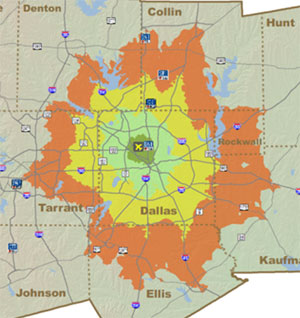
Access to the surface transportation system is key to an airport’s economic viability. Congestion-free access to regional airports helps a system sustain growth and encourage prosperity. This is especially true in North Central Texas where the vast aviation network consists of two commercial service airports, 11 reliever airports, and over 40 additional GA facilities. The Federal Highway Administration (FHWA) has established criteria for providing funding for airport surface access improvements. These roadways, called intermodal connectors, link airports to major U.S. highways and interstates. Generally, only airports with commercial service or significant cargo operations qualify for funding under FHWA’s criteria. Currently, roadways surrounding Dallas/Fort Worth International Airport (DFW), Dallas Love Field (DAL), and Alliance Airport (AFW) have designated intermodal connectors.
The Federal Aviation Administration (FAA) and U.S. Department of Transportation (DOT) have encouraged the involvement of airport sponsors in planning and policy committees of Metropolitan Planning Organizations (MPO). The North Central Texas Council of Governments (NCTCOG), as the MPO for North Central Texas, actively promotes congestion management and improved air quality. A regional assessment of ground access at GA facilities reinforces the link between the System Plan’s multimodal facility recommendations and future airport ground access needs. This assessment takes note of existing plans for regionally significant surface transportation projects within each airport’s impact area.
Ground access assessment observations and recommendations include:
- In most instances, the growth in roadway traffic volume occurs at airports located in areas where developable land is available to accommodate both the growth and the resulting facility needs.
- Airport sponsors are encouraged to work with their local planning organizations to incorporate airport ground access needs into overall community-based plans.
- Enhancements to the travel demand models used by NCTCOG to forecast future surface transportation needs should be considered, in order to include forecasted airport activity as a factor in future traffic volumes.
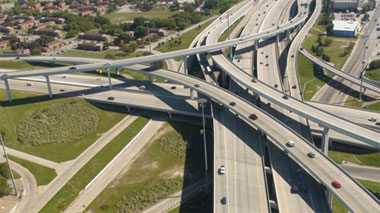
Airports located centrally within higher growth areas have more programmed projects and committed funds within their impact areas than those near MPO boundaries or in slower growth areas. Although it appears that GA airports have been considered by the MPO in the programming of surface transportation improvements, it is unlikely that the airport’s operations were a deciding factor in the project selection. Going forward, NCTCOG will encourage the inclusion of GA airport ground access needs in the surface transportation system’s funding decisions.
Demonstration Encroachment Analysis

North Central Texas remains a rapidly growing region despite the international recession that began in 2008. By 2040, the region is expected to be home to more than ten million residents and over six million jobs. Although this kind of growth provides many economic benefits, it can lead to concerns about airport encroachment. Airports feel the pressures of urban encroachment in a variety of ways; residential development, height hazards, and other incompatible land uses. As growth continues, protecting and maintaining safe and navigable airspace around airports will be a challenge that must be met by airport sponsors to avoid future limitations on airport service. Obstructions from proposed building construction, communication towers, drilling rigs, and cranes can greatly affect aircraft operations. The FAA is not tasked with the prevention of encroachment on airports, although an existing FAA Obstruction Evaluation/Airports Airspace Analysis (OE/AAA) reporting process helps monitor growth and development. Preventing construction of objects hazardous to air navigation is a local responsibility.
Local governments should foster compatible land-use planning and development surrounding an airport or heliport to enable the long-term development of the facility and adjacent property for the benefit of the community and region. This includes protection of the land and the airspace.
The following actions are recommended for local governments with an airport in their jurisdictions:
- Implement zoning to prevent future incompatible development, both land and airspace.
- Protect or acquire land for future planned airport expansion, including runway extension and additional facilities.
- Discuss future plans for the airport with local development groups and political jurisdictions and review all proposed city and development projects adjacent to the airport to ensure long-term compatibility.
- Explore establishing an airport council to guide development. It should be comprised of members with different relevant positions within the government of nearby communities.
- Update airport documentation, such as the Airport Layout Plan (ALP), to reflect new airport goals.
- Educate city councils, planning and zoning commissions, and boards of adjustment about the airport’s importance and the desired zones of protection to ensure its future viability.
 Addison Airport 2008
Addison Airport 2008 NCTCOG offers a handbook, A Guide for the Public – Preserving General Aviation Airports in North Texas, for use as a tool by local governments, airports, and community organizations to assist in publicizing the roles of airports, how encroachment has detrimentally affected them in the past, and how compatible land-use practices can preserve them for the future. More information on this tool is available here.
General Aviation Air Cargo
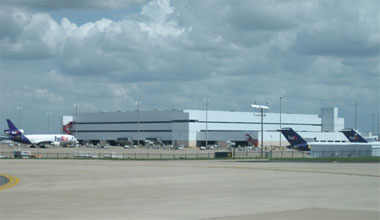
As the largest inland port in the nation, North Central Texas is a leader in global and domestic trade because of its vast system of highways, rail lines, and airports. According to the Dallas Regional Chamber of Commerce, the total value of registered imports and exports at the region’s airports has nearly doubled since 2000, from $30 billion a year to $57 billion a year in 2008. In 2010, the Dallas-Fort Worth International Airport and Fort Worth-Alliance Airport landed 3,732,532,090 pounds of cargo. DFW is ranked 9th in the country for air cargo. This success can be attributed to the presence of major distribution centers for Federal Express and United Parcel Service (UPS), the nation’s largest Foreign Trade Zone located at AFW, and a superior network of GA airports. The ability to ship air cargo is essential for the economic growth of a region.
While DFW, AFW, and DAL provide scheduled air cargo operations, several of the region’s GA airports aid businesses by allowing them to provide critical, just-in-time cargo shipments to their customers. Smaller GA airports can help make possible the seamless flow of goods to and from North Central Texas.
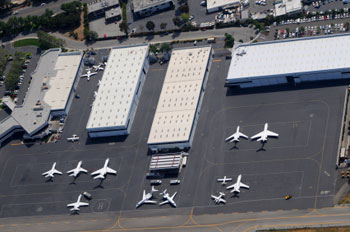
With the exception of AFW, no other GA airport has dedicated air cargo facilities such as ramps, warehouses, or sorting centers. However, many have common aircraft ramp areas capable of handling all-cargo aircraft. A regional assessment reveals that several GA airports have limited air cargo activity or expectations for such in the future. At these locations, air cargo service may consist of occasional flights by turbo-prop or corporate jets carrying high value or priority goods. The value of the item to the sender and recipient is generally considered to be substantial in order to warrant the expenditure of an air cargo operation.
Generally, airport managers are pleased to receive whatever air cargo business might be available, but they are not actively soliciting it. Rather, most airport managers note that air cargo routes, facilities, and operators are established at the large regional airports, so they perceive there to be little gain in seeking this business. On the other hand, airport managers who express an interest in air cargo have unique reasons, such as local business opportunities and providing for future transportation infrastructure.
Regional Airspace Analysis
Airspace, by its nature, is a finite resource and must be managed wisely to avoid saturation. While the current airspace system is effectively managed, airspace in North Texas could become overly congested at some point in the future. North Central Texas airspace is heavily influenced by the Class B airspace surrounding DFW and DAL. Their central location and proximity to each other creates irregularities in the Class B design, impacting the flow of GA traffic traversing the region and in and out of the airports due to the control necessary for safe operations. Pilots must be familiar with the operations in Class B airspace and use extra caution due to the large volume of jet traffic.
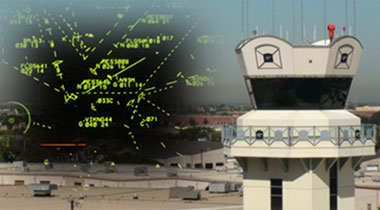
The Next Generation Air Transportation System (NextGen) is a multi-faceted federal initiative to combine the capabilities of satellite-based and other emerging technologies with the need to accommodate increasing levels of air traffic. The NextGen program seeks to implement safer and more efficient departure, en route, and arrival procedures to improve the overall capacity of the nation’s airport/airspace system. The continuing implementation of the NextGen program moves away from ground-based surveillance and navigation equipment and procedures and places a greater reliance on the capabilities and flexibilities of new and more dynamic Global Positioning System (GPS) technology.
NextGen will have an effect on several aspects of the region’s aviation system. From an airspace standpoint, pilots will have the ability to specify direct routes for their flight rather than fly formally established routes. They will also have real-time, accurate information about other pilots in the immediate area and the surrounding weather. This data transferred electronically through the NextGen system will reduce the volume of communication and information required to be processed through Air Traffic Control (ATC), thus increasing the overall level of traffic volume that can be handled.
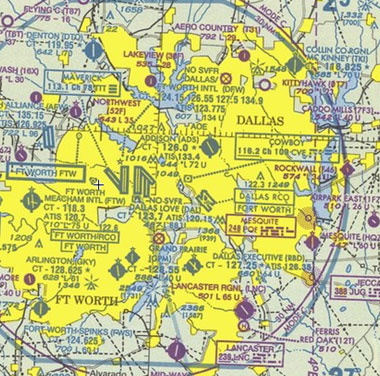
In September 2005, the FAA implemented Area Navigation (RNAV) Standard Instrument Departures (SID) at DFW using GPS technology. RNAV allows pilots to fly directly from one pre-assigned point (or waypoint) to another, rather than having to depart using vectors or assignments from ATC. This has resulted in better traffic flow in the terminal airspace surrounding DFW. Cost savings, reduced communication errors, and increased departure capacity have also been realized since implementation.
NextGen serves to expand the capacity of the national air transportation system by encouraging the use of underutilized airport and terminal facilities. By providing the same capabilities available to larger airports, a broader definition of “reliever airport” can expand the ability of congested regions to handle increased activity without requiring extensive capital improvements. The implementation of NextGen will help to ensure adequate room to accommodate future traffic and allow for the development of a new approach and departure procedures for each of the region’s airports.

